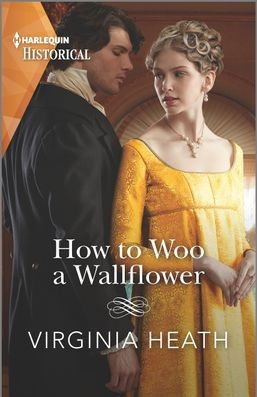
How to woo a wallflower is the latest Mills and Boon book by the prolific Virginia Heath. It's the first in a trilogy (by different authors) and it sets the scene nicely. I look forward to reading the other stories on the back of this one.
I particularly liked that the heroine, Hattie, is disabled, having not recovered properly from a broken leg. She is not magically cured as so often happens in fiction, and we never think she is going to be. Instead, she learns to live with her new normal and comes to realise it doesn't define her. While some people see her as damaged, those who count do not. The disability and the discrimination it caused were very real.
Hattie's disability also allowed us a glimpse at High Society and its underdogs. We saw the Earl of Boredom, who wants her money and connections and is willing to accept her disability to get them, and who clearly feels he is doing her a favour by offering her marriage. We also meet the wallflowers, which Hattie only joins because of her leg. I loved The Wallflowers of 1813 Club. I could see fabulous stories in there.
Jasper is a great hero, and a fitting match for Hattie. He is flawed, partly because he's had to be. He has the common sense to realise going into business is not more shaming than going bankrupt, no matter what Society might think, and he does what needs to be done. Although classed as a rake with a blackened reputation, he steps up and takes responsibility even when he doesn't have to do so, both for Izzy, and in the myriad ways he helps Hattie. Many men with pristine reputations would not have been so honourable.
Hattie has carved a role for herself helping the poor, and through her Jasper discovers a whole side to London he had never considered before. Through his eyes, we see the poverty and harshness of life and the struggles for those not born to privilege. It added depth to the book, and to the characters.
I also liked Freddie. Hattie's overprotective and overbearing brother is a nightmare, though his motives are pure. He mollycoddles Hattie, and feels her damaged leg means she can no longer think for herself or live her life. The depiction of him was very true to life, and his is an attitude many disabled people must put up with, even in 2022.
I found Hattie’s parents less believable. They were so wrapped up in themselves that they were blasé about Hattie’s life. I did think they would probably have paid lip service to Society's mores, even if, privately, they didn't mind what she was doing. They would have insisted she behave as Society would wish, if only because they have another daughter to launch. Even parents who don't care usually like the public to think they do. But for the purposes of the story, I could accept there loving neglect of her.
The one criticism I really have of the book is the initial meeting of Jasper and Hattie. The whole scene is in dialogue; not in itself a bad thing, but much of this dialogue was on-the-nose, telling the reader things by having the characters tell each other, even though they know the other person would already have the information. It's an infodump of a conversation.
This technique worked in Ms Heath’s previous book, “The Earls Inconvenient Houseguest,” because the conversation there was between village gossips and the object of their conversation could overhear them, which was the whole point. It is not so effective in a private conversation between two people who know each other well. The on-the-nose conversations do not happen again throughout the book however, so this one may have been an aberration.
Overall, this was an enjoyable book, and Jasper gives Jack Warriner (another Virginia Heath hero) a run for his money as the Hero I'd Most Like To Meet.

Comments